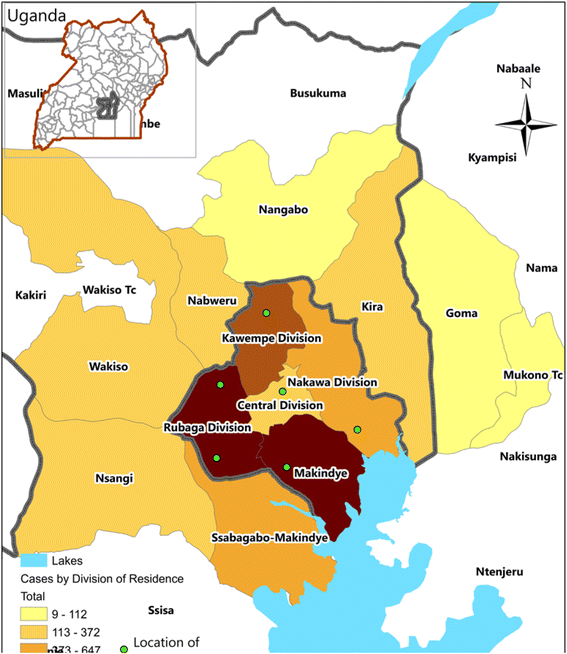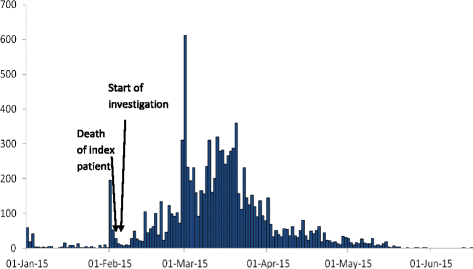A large and persistent outbreak of typhoid fever caused by consuming contaminated water and street-vended beverages: Kampala, Uganda, January - June 2015
- PMID: 28056940
- PMCID: PMC5216563
- DOI: 10.1186/s12889-016-4002-0
A large and persistent outbreak of typhoid fever caused by consuming contaminated water and street-vended beverages: Kampala, Uganda, January - June 2015
Erratum in
-
Correction to: A large and persistent outbreak of typhoid fever caused by consuming contaminated water and street-vended beverages: Kampala, Uganda, January - June 2015.BMC Public Health. 2017 Oct 18;17(1):823. doi: 10.1186/s12889-017-4801-y. BMC Public Health. 2017. PMID: 29047373 Free PMC article. No abstract available.
Abstract
Background: On 6 February 2015, Kampala city authorities alerted the Ugandan Ministry of Health of a "strange disease" that killed one person and sickened dozens. We conducted an epidemiologic investigation to identify the nature of the disease, mode of transmission, and risk factors to inform timely and effective control measures.
Methods: We defined a suspected case as onset of fever (≥37.5 °C) for more than 3 days with abdominal pain, headache, negative malaria test or failed anti-malaria treatment, and at least 2 of the following: diarrhea, nausea or vomiting, constipation, fatigue. A probable case was defined as a suspected case with a positive TUBEX® TF test. A confirmed case had blood culture yielding Salmonella Typhi. We conducted a case-control study to compare exposures of 33 suspected case-patients and 78 controls, and tested water and juice samples.
Results: From 17 February-12 June, we identified 10,230 suspected, 1038 probable, and 51 confirmed cases. Approximately 22.58% (7/31) of case-patients and 2.56% (2/78) of controls drank water sold in small plastic bags (ORM-H = 8.90; 95%CI = 1.60-49.00); 54.54% (18/33) of case-patients and 19.23% (15/78) of controls consumed locally-made drinks (ORM-H = 4.60; 95%CI: 1.90-11.00). All isolates were susceptible to ciprofloxacin and ceftriaxone. Water and juice samples exhibited evidence of fecal contamination.
Conclusion: Contaminated water and street-vended beverages were likely vehicles of this outbreak. At our recommendation authorities closed unsafe water sources and supplied safe water to affected areas.
Keywords: Case-control; Outbreak; Typhoid fever; Uganda.
Figures


References
-
- Heymann DL. In: Control of Communicable Diseases. An Official Report of the American Public Health Association. 20. Heymann DL, editor. United States of America: Alpha Press; 2014.
-
- World Health Organization. The diagnosis, treatment and Prevention of Typhoid Fever. World Health Organisation, Department of Vaccines and Biologicals: CH-1211 Geneva 27; 2003. WHO/V&B/03.07.
-
- Centers for Disease Control. Typhoid Fever 2013. Available from: https://www.cdc.gov/typhoid-fever/index.html. Accessed 27 July 2015.
MeSH terms
Substances
Grants and funding
LinkOut - more resources
Full Text Sources
Other Literature Sources
Medical
Miscellaneous

